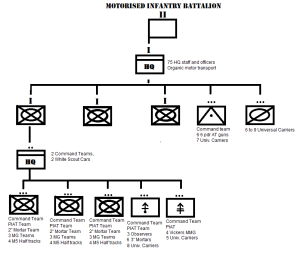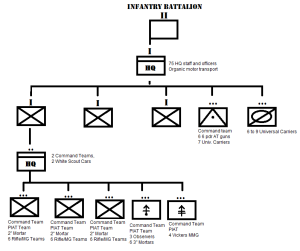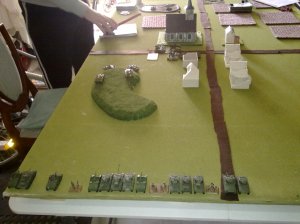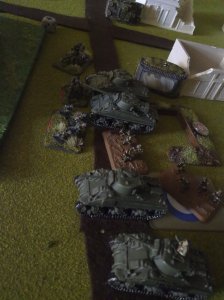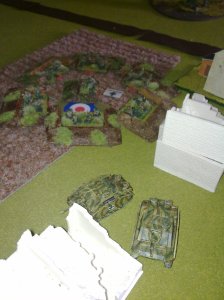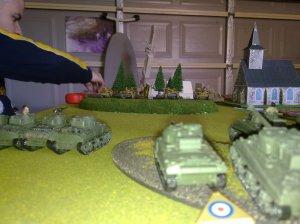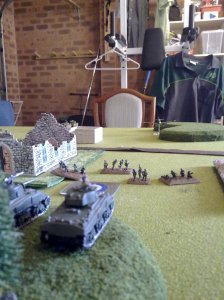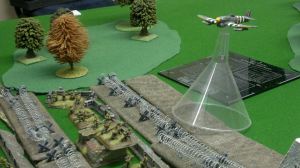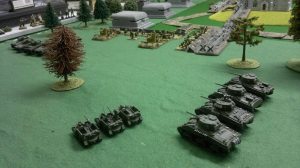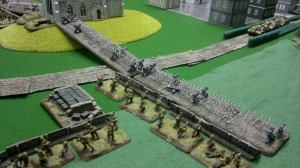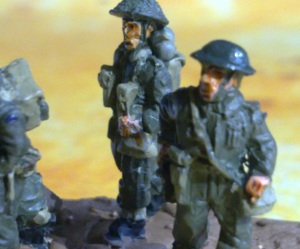In-game date: 10 June 1944
In-game location: A few kilometres West of Creully
Op Overlord Username: Peter28842
Opponent Username: Andrew R
Battle Type: Cauldron, Germans attacking
Result: Draw – Allies 3, Germans 3
Allied Forces
Able Company, 21st Motorised Rifle Battalion (represented by Kompania Piechoty from Polish 1st Armoured Division) – Fearless Trained: 1,500 pts
HQ: Captain Ellis Sunday (Cmd Rifle), Lieutenant James Bishop (2IC Rifle)
1 Platoon: Cmd Rifle, PIAT, 2” Mortar, 6xRifle/MG Teams
2 Platoon: Cmd Rifle, PIAT, 2” Mortar, 6xRifle/MG Teams
Mortar Platoon: Cmd Rifle, PIAT, 4×3” Mortars
Anti-Tank Platoon: Cmd Rifle, 2x6pdr AT guns
Machine-gun Platoon: Cmd Rifle, PIAT, 4xVickers HMG
Transport Platoon: 4x 3 Ton CMP trucks
3 Platoon, 6th Armoured Bn: 3xSherman V, Sherman Firefly
4 Platoon 6th Armoured Bn: 3xSherman V, Sherman Firefly
Limited Air Support: Hawker Typhoons of the Caledonian Air Force.
German Forces
Panzer Company – Confident Veteran – 1,500 pts
HQ: 2x StuG III
Panzer Platoon: 3xPanzer IV
Schwere Panzer Platoon: one Tiger I
Assault Gun Platoon: 5xStuG III
Panzergrenadier Platoon: Cmd MG with Panzerfaust, 6xMG Teams with a staff car and trucks
Limited Air Support: Junkers Ju-87G ‘Stuka’
Allied Casualties
1 Platoon: 3xRifle/MG Teams KIA
2 Platoon: 1xCmd Rifle KIA, 3xRifle/MG Teams KIA
Mortar Platoon: PIAT Team, 3” Mortar Team KIA
3 Platoon, 6th Armoured Bn: Destroyed
4 Platoon 6th Armoured Bn: Destroyed
German Casualties
HQ: Command StuG III fled
Assault Gun Platoon: 3xStuG IIIs destroyed, 1xbailed, 1x fled
Panzer Platoon: Panzer IV destroyed
Schwere Panzer Platoon: Tiger I destroyed
As the armoured striking power of the 1st Caledonian Mechanised Division continued its drive south and west, attempting to outflank the town of Bayeux, the Infantry Battalions of VI Infantry Brigade followed in their wake, holding a series of defensive positions at key points guarding the flanks, each Battalion ‘leapfrogging’ each other along the line to keep up as the armoured spearhead advanced. One such key point, on the western flank, was at the small town of Saint-Gabriel – a village, like so many, surrounded by bocage fields and dominated by a church. Occupying a salient projecting into German-held territory, was Able Company of the 21st Infantry Battalion – considered by some as a second rate unit, the 21st had nevertheless been in action at a number of points along the advance into the Norman hinterland following the D-Day landings, and had lost its commander, Major Garrett Willis on 8 June. Major Willis was replaced by Captain Ellis Sunday – a dull and unremarkable, but undoubtedly dedicated officer, who was about to fight a fairly unremarkable, but nevertheless tragic action.
After Action Report
Deployment
Captain Sunday’s force arrived on the night of 9 June and by morning had established fairly strong positions guarding the key terrain (objectives): the eastern periphery of the village on one side, and a thick stand of trees that marked the border of the western side. 1 Platoon took up a choice position among the houses on the eastern side, and 2 Platoon dug in among the trees to guard the western objective. Captain Sunday set up office in the centre of the town, and made sure his two 6pdr guns were dug in in concealed ambush positions along the verges of the east-west road running down the centre of the town. These guns, it was felt, would ensure any German armoured assault would face stiff resistance.
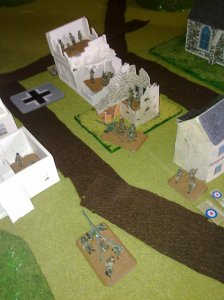 1 Platoon and the 6pdrs positioned in the village.
1 Platoon and the 6pdrs positioned in the village.
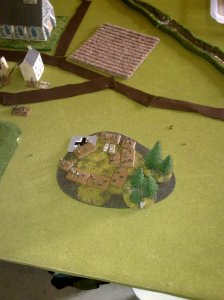 2 Platoon encamped in the woods to the west.
2 Platoon encamped in the woods to the west.
Seeing Saint-Gabriel as a decisive point along the flank of the troublesome Caledonian Division, the German commander assembled as many armoured vehicles as he could: a large assault gun platoon, with support from a rare heavy Tiger I would lead the assault, and Panzer IVs and Panzergrenadiers would follow. The plan was simple – blast the Caledonian infantry from a distance, and then overwhelm the remnants.
A Tiger is doomed
It was mid-day by the time the German panzer assault commenced. The riflemen of the 21st first noticed something was afoot when they saw a pair of Typhoons scream down and loose off a volley of rockets at some unseen target over a nearby hill. They would find out later, what the vigilant pilots of the patrolling fighter-bomber squadron had spared them: for the rocket attack had destroyed a StuG III and a Tiger tank! (Paul R’s unfortunate Tiger hasn’t had much success – either not showing up for the battle at all, being taken out by a PIAT in close combat, a Sherman 75mm shot in the rear, and being driven off by Aussie infantry in assaults on two occasions).
 The Panzer battle line in the distance.
The Panzer battle line in the distance.

The Caledonian Air Force destroys the luckless Tiger!
The remaining German StuGs now lined up and advanced across a line of low hills toward the village from the south, hurling their shells at the buildings on the eastern edge. Grim-faced Caledonian riflemen clutched their helmets and held on amid the dust and falling rubble. The German StuG commander had evidently radioed in the position of his enemy, as a Stuka dive-bomber swooped in to drop a 500kg bomb on a building in which a section was sheltering – killing a Rifle/MG Team. Evidently the Allies didn’t have total air superiority in this sector.
The rest of the Germans arrive
As the StuGs continued their bombardment of Saint-Gabriel, three Panzer IVs rolled in to take up position alongside them. Together, the two platoons pounded the once lovely facades of the French houses into shell-marked and blasted remnants. Another two Rifle/MG teams were destroyed. The German vehicles were at close range now, and a few brave men rushed between the buildings to help their wounded comrades. 1 Platoon continued to hold, awaiting what seemed like the inevitable assault. The crews of the 6pdr AT guns, lying low in the drainage ditches either side of the central street watched the helplessness of the infantryman in the buildings to their front and opened up on the Panzer IVs. Their shells had no effect and they had given away their position. Captain Sunday couldn’t blame the AT crewmen for wanting to help their comrades, even though he’d wanted them to stay quiet until the Panzers were up close. He gave no orders, but went about among the men, saying quietly to each one – ‘hold on, hold on.’
An Observer spotted a line of German Kfz trucks racing around the hills to the north-east. A choice target, he tried frantically to raise an Air Force Forward Observer or liaison team on the radio, but to no avail! The Observer pounded the ground in frustration as the golden target slipped away and out of sight. The German trucks delivered their Panzergrenadiers and quickly drove off. As the German’s began siting their MG42s on the hillside overlooking the town, Captain Sunday gave one of his only orders of the entire battle – as the entire German force was now in position on the eastern side of the village, he brought 2 Platoon in to take up a position on the north-western hill opposite the Germans – they would guard the flank of 1 Platoon.
 Panzers close in on Saint-Gabriel.
Panzers close in on Saint-Gabriel.

Yet more Germans arrive. 2 Platoon changes position.
 A Stuka bombs 2 Platoon, who are now caught in the open.
A Stuka bombs 2 Platoon, who are now caught in the open.
Things looked grim for 21st Battalion. Radio calls had been sent out, but nobody seemed to be listening. Suddenly, it seemed as if the cavalry had arrived – a column of Shermans from 6th Armoured Battalion had at that moment been moving in convoy with some support troops from the 21st Motor Battalion along the road behind Saint-Gabriel on the way to the front. Heeding the call, a platoon that including a Firefly moved in behind the German ‘panzer line’ and began losing off shots. Two StuG IIIs exploded in columns of smoke and another was penetrated. Startled, the remaining StuG drivers put their feet to the floor and sped off, with their distraught Company Commander in pursuit, desperately trying to rally them. The German 2IC now took control. Turning his attention from the village to the oncoming Shermans, he led the Panzer IVs southward.
 3 Platoon Shermans surprise the StuG IIIs!
3 Platoon Shermans surprise the StuG IIIs!
Stuka and Panzer attack
Another Stuka swooped down and destroyed a Sherman, and while the Sherman 3 Platoon commander stared in horror, the Panzer IVs and Command StuG turned his and another Sherman V into flaming wrecks. Only the Firefly held on fearlessly, destroying a Panzer IV before it was knocked out. The second Sherman platoon in column, 4 Platoon, then arrived.
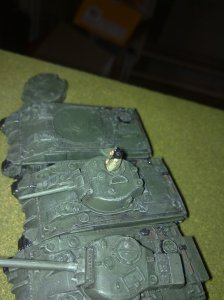 The 3 Platoon commander looks on, horrified, as the turret of one of his Shermans is lifted clear into the air from an explosion of a Stuka bomb.
The 3 Platoon commander looks on, horrified, as the turret of one of his Shermans is lifted clear into the air from an explosion of a Stuka bomb.
2 Platoon, now dug in on the north-west heights near the town, were suffering. The Luftwaffe had control of the air over this battlefield, and a number of Stuka attacks went in, killing some riflemen, although most bombs fell astray. The Panzergrenadiers held back from the village and hammered away, pouring their incredible firepower into 2 Platoon. 2 Platoon, their Bren guns totally outmatched by German MG42s, lost more Rifle/MG teams and their Platoon command team. They stoically held on however – for their mates in the village below.
The Shermans of 4 Platoon opened fire on the Panzers but their targetry was hideously poor. Outshot by the veteran Panzer IV crews, and outmanoeuvred, they were destroyed just as Mortar and Vickers HMG teams marched up to their rear, hoping to reinforce their comrades in the village. To their horror they had marched straight into a German tank assault! A 3”mortar team and a (critically) the PIAT team were gunned down immediately. The Vickers platoon, furthest from the Germans ran into the cover of the woods by the roadside, while the Mortar crews, determined to make a stand, set down their tubes and lobbed a number of hopeful shots at the Panzers. An incredibly luck shot exploded next to a German tank commander, causing the jumpy and panicked crew to bail out. The mortar platoon stood beside their weapons and readied more rounds – they were doomed, they knew, but they would fight to the death to allow the Vickers platoon to escape!
 The Panzers had won the tank battle, but the village had remained in Allied hands.
The Panzers had won the tank battle, but the village had remained in Allied hands.
By this stage the sun was setting and both sides, severely battered, knew they could not continue the fight. The remaining Panzers and StuG III moved back, using the growing darkness to conceal them from Allied air attack. The astonished mortar men and Vickers machine-gunners felt as if they had been pardoned on the gallows! Relieved, they made their way quietly back toward their own lines in the opposite direction from the Panzers.
The Germans had not taken Saint-Gabriel, but their infantry had taken possession of the north-eastern heights overlooking the town. As darkness fell, the survivors of the beleaguered 21st Infantry Battalion moved around in the now quiet town, counting the dead, evacuating the wounded, re-establishing shelled positions. Captain Sunday looked at the dust-smeared faces of his men with a blank and sad expression. The men’s courage had held, but he felt he had let them down somehow. He said nothing, as was his way. There was nothing to be said.









